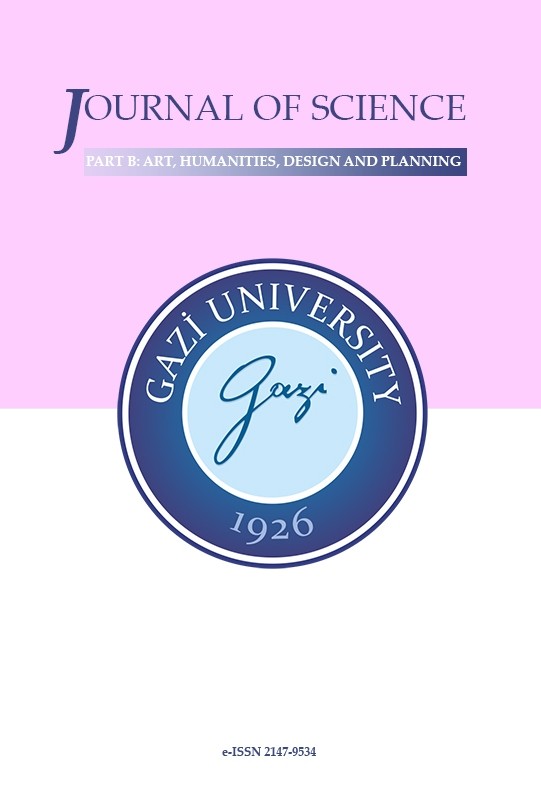Embedding Inclusive Design Knowledge into the Learning Process in Architectural Education
Embedding Inclusive Design Knowledge into the Learning Process in Architectural Education
___
- [1] Heylighen, A. (2008). Sustainable and inclusive design: a matter of knowledge?, Local Environment, 13(6), 531-540.
- [2] Clarkson, P. J., Coleman, R., Keates, S., & Lebbon, C. (2003). Inclusive design: Design for the whole population. UK: Springer.
- [3] Ostroff, E. (1997). Mining Our Natural Resources: The User as Expert. Innovation, the Quarterly Journal of the Industrial Designers Society of America, 16(1).
- [4] Coleman, R., Clarkson, J., Dong, H. & Cassim, J. (2007). Design for Inclusivity: A Practical Guide to Accessible, Innovative and User-Centred Design. UK: Gower Publishing.
- [5] Dinç, Uyaroğlu, İ. (2023). “Mahallede Kapsayıcı Kamusal Yaşam İçin Erişilebilirlik Denetimi [Controlling Accessibility for an Inclusive Public Life in a Neighbourhood]”, Planlama, 33(1), 123-142.
- [6] Dinç Uyaroğlu, İ. (2015). Performance evaluation and design guidelines for equitable access of students with disabilities in university campus outdoor environments. Unpublished PhD thesis, Middle East Technical University, Ankara.
- [7] Helvacioglu, E. & Karamanoğlu N. N. (2012). Awareness of the Concept of Universal Design in Design Education. In Procedia - Social and Behavioral Sciences, 51, 99-103.
- [8] Sungur Ergenoglu, A. (2013). Accessibility awareness among architecture students: Design thinking evaluations in Yıldız Technical University. In Procedia-Social and Behavioral Sciences, 89, 312-317.
- [9] Heylighen, A., Van der Linden, V. & Van Steenwinkel, I. (2017). Ten questions concerning inclusive design of the built environment. Building and Environment, 114, 507-517.
- [10] Barnes, C. and Mercer, G. (2003). Disability. UK: Polity.
- [11] Dinç Uyaroğlu, İ. (2008). Architectural Implications of Community-Based/Inclusive Rehabilitation Centers in the Light of Universal Design. Unpublished Master Thesis, Middle East Technical University, Ankara.
- [12] Tutal, O. (2018). Üniversite Yerleşkeleri ve Erişilebilirlik. Avrasya Uluslararası Araştırmalar Dergisi, 6(15), 753-775.
- [13] Baş Bütüner, F. & Güneri Söğüt, G. D. (2022). Mimarlık ve Peyzaj: Eğitime Dair Kesitler, Vaatler. Mimarlık, 428, 36-40.
- [14] Dong, H. (2010). Strategies for teaching inclusive design. Journal of Engineering Design, 21(2–3), 238-251.
- [15] Demirkol, H. G. & Döşer, M. Ö. (2022). Stüdyo Kültürü Bileşenleri. In Ö. Kandemir (Ed.), Mimari Tasarıma Gir-İş-Ler: Mimarlık Birinci Sınıf Stüdyo Belleği. Ankara: İksad Publications.
- [16] Olguntürk, N. & Demirkan, H. (2009). Ergonomics and Universal Design in Interior Architecture Education. METU Journal of Faculty of Architecture, 26(2), 123-138.
- [17] Sungur Ergenoglu, A. (2015). Universal design teaching in architectural education. In Procedia-Social and Behavioral Sciences, 174, 1397-1403.
- [18] Gheerawo, R.R. & Donahue, S.J. (2004). Introducing user-centred design methods into design education. In S. Keates, J. Clarkson, P. Langdon & P. Robinson (Eds.), Designing a More Inclusive World, 21–30. London: Springer.
- [19] Mulligan, K., Calder, A. & Mulligan, H. (2018). Inclusive design in architectural practice: Experiential learning of disability in architectural education. Disability and Health Journal, 11(2), 237-242.
- [20] Altay, B. (2017). Multisensory Inclusive Design Education: A 3D Experience. The Design Journal, 20(6), 821-846.
- [21] Hitch, D., Dell, K. & Larkin, H. (2016). Does universal design education impact on the attitudes of architecture students towards people with a disability?. Journal of accessibility and design for all, 16(1), 26-48.
- [22] Christophersen, J. (Ed.) (2002). Universal Design: 17 Ways of Thinking and Teaching. Norway: Husbanken.
- [23] Rowe, P. G. [1987] (1998). Design Thinking. USA: MIT Press.
- [24] De Cauwer, P., Clement, M., Buelens, H. & Heylighen, A. (2009). Four reasons not to teach inclusive design. In Proceedings of Include 2009. London: Royal College of Art, Helen Hamlyn Centre.
- [25] Bilsel, C. (2010). Kent Tasarımı ve Çevre Estetiği. In J. Erzen (Ed.), Kent Estetiği, Dosya, 23, TMMOB Mimarlar Odası Ankara Şubesi Süreli Yayını, 6-14.
- Yayın Aralığı: Yılda 4 Sayı
- Başlangıç: 2013
- Yayıncı: Gazi Üniversitesi
Hazal ARTUN, Esra LAKOT ALEMDAĞ
Reading the Transformation of Interior Space Perception through Technology
Embedding Inclusive Design Knowledge into the Learning Process in Architectural Education
Extracting Data-Driven User Segments and Knowledge by Using Online Product Reviews
Mahmut Ferit AYDIN, H. Güçlü YAVUZCAN
Material Used in 3-Dimensional Printing Technology in the Construction Industry
Historical Evaluation of Public Toilets as Public Spaces
Ergin Kemal KOCAİLİ, Can Mehmet HERSEK
Feshane-i Amire Evaluation of Structural System for Adaptive Reuse
